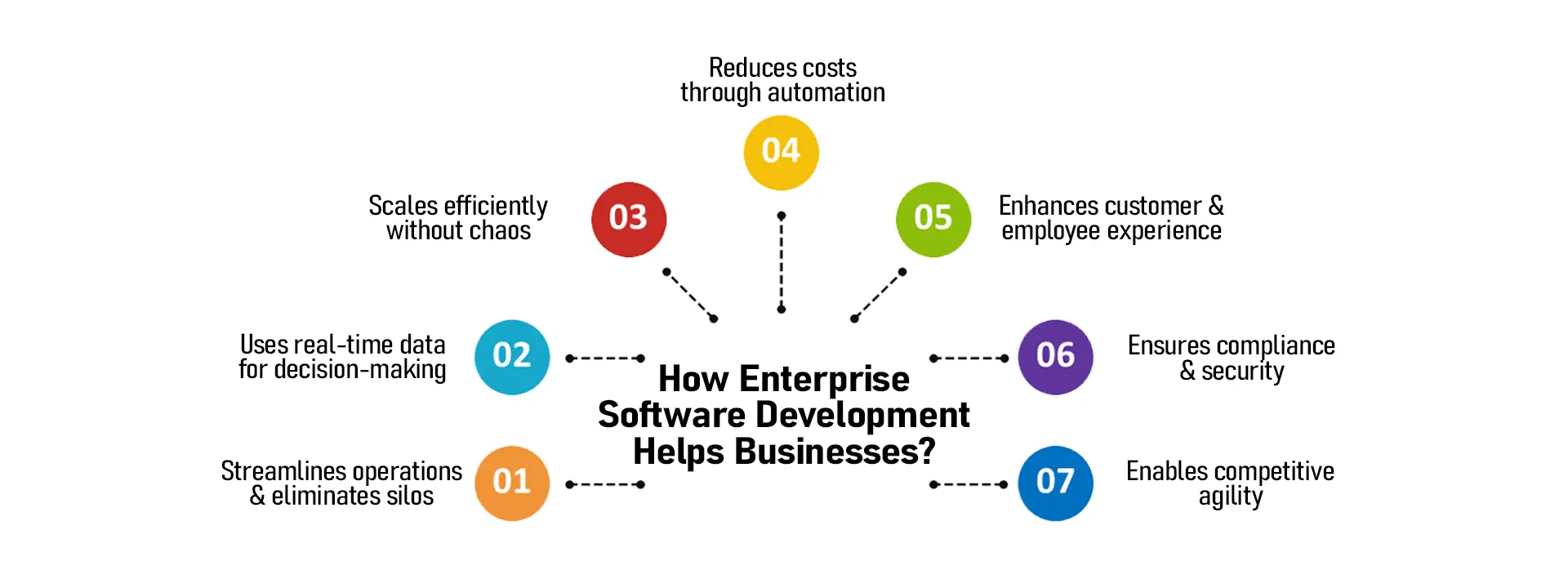Although enterprise software development is primarily aimed at supporting and automating the operations and processes of large enterprises, mid-sized businesses can also benefit by carefully evaluating the cost, complexity, and scalability.
In this blog, we’ll discuss how mid-sized business leaders can benefit from enterprise software development, when to invest, and the best approaches involved.
Is Enterprise Software Development Also for Mid-Sized Businesses?
As the name suggests, the scale of development is primarily considered an exclusive domain reserved for managing complex and large-scale operations and processes.
However, mid-sized businesses can also design, build, and deploy scalable, integrated solutions for their automation and innovation needs.
For example, an emerging manufacturing company can develop an ERP system to automate inventory tracking, streamline supply chain operations, and integrate sales and accounting, all within a unified platform.
How Does It Help Businesses?
Business leaders in the mid-market segment face unique challenges. For instance, their operations are too large for basic tools but may lack the resources of giant corporations. Learn how it helps:
Streamlines operations & eliminates silos
Second-stage businesses often struggle with disconnected tools for finance, sales, customer relationships, and other functions. This lack of integration creeps in inefficiencies, as employees have to manually transfer data between systems, leading to errors, delays, and redundant efforts.
Enterprise software development centralizes operations, ensuring that all business functions work together seamlessly through a unified platform. By integrating workflows across departments, you can eliminate bottlenecks, enhance collaboration, and maintain a single, accurate source of truth for all your data.
Uses real-time data for decision-making
Business leaders love to get their hands on timely and accurate insights for effective decision-making. Yet many businesses rely on outdated or fragmented reports accumulated from multiple sources. Such unauthentic reports are the reasons for slow responses to market changes, missed opportunities, and inappropriate resource allocation.
Enterprise level software development offers real-time dashboards, AI-based analytics, and forecasting tools that help leaders in making data-driven decisions. Whether it’s tracking sales patterns, forecasting demand, or evaluating operational efficiency, real-time insights enable you to proactively adjust strategies, optimize pricing, and enhance overall performance.
Scales without chaos
Outdated systems can become a real pain in the brain, stopping your business growth at every possible moment. For example, spreadsheets or on-premise databases may struggle to handle increasing data volumes, additional users, or complex processes.
Robust applications are designed to scale with your business. Cloud-based platforms, modular architectures, and powerful integration features encourage companies to expand without spilling their entire IT infrastructure. Whether adding new users, handling higher transaction volumes, or expanding into new markets, enterprise custom software development helps you scale without hindering day-to-day operations.
Reduces costs through automation
How much of your workforce are you currently allocating to invoicing, payroll, data entry, customer service, and other manual processes? These tasks consume excessive time, increase errors, and significantly impact profitability, especially as businesses grow.
Corporate software development featuring automation tools is capable of automating repetitive tasks, reducing administrative hours, and operational costs. With machines and programs handling the tedious legwork, you don’t need to overload your teams with excessive workforce. Instead, let the programs speed up processing times, freeing employees to focus on higher-value tasks.
Enhances customer & employee experience
Not everything that comes out of a digital product is quantitative. Some elements are more qualitative in nature, which further makes way for numbers to complement your business growth. The case with customer and employee experience is no different.
Customers expect seamless interactions, whether they are purchasing a product, seeking support, or tracking an order. Similarly, your employees need efficient systems to perform their tasks without delays or unnecessary complexity. And enterprise applications centralize customer and employee experiences by connecting sales, support, HR, and operational functions.
Such activities ensure that customer-facing teams have complete visibility into interactions, improving service quality. Second, employees benefit from streamlined workflows, quick self-service options, and better communication tools.
Ensures compliance & security
Leaders, regardless of their company’s size and nature of business, must recognize that regulatory requirements are becoming increasingly complex, particularly in industries such as healthcare, finance, and manufacturing. And non-compliance can lead to legal penalties, reputational damage, and operational disruptions. Moreover, cybersecurity threats are growing, making data protection an unignorable concern.
Enterprise-grade systems are built with compliance and security as top priority. Advanced security features, like access controls, encryption, and audit trails, protect sensitive data. Today, enterprise software developers also add built-in compliance frameworks for industry regulations, such as GDPR, HIPAA, or SOC 2, ensuring that respective businesses meet legal standards safely.
Enables competitive agility
Wanting your business to stay ahead of your competitors is a no-brainer; however, innovation is a prerequisite. In other words, companies that depend on outdated technologies find it difficult to adopt new trends, such as hyperautomation and other emerging technologies, thereby putting them at a disadvantage.
Enterprise solutions equip business leaders with state-of-the-art tools that drive agility and innovation. In short, AI-driven analytics, automated workflows, and customizable solutions enable businesses to quickly adapt to changing market conditions, launch new services, optimize operations, and establish a strong foothold against larger enterprises.

When Should You Invest in Enterprise Software Development?
Every business leader has their own goals and future preferences regarding digitalization. However, the following situations can help you recognize your position and determine when to opt for technical development or assistance.
Rapid growth
If you’re on the cusp of business expansion, whether by opening new offices, hiring more employees, or diversifying your service offerings, manual processes and disconnected systems can become bottlenecks.
Platforms such as ERP and CRM systems help businesses manage data, workflows, and customer interactions more effectively. And without a scalable system in place, businesses risk inefficiencies, operational delays, and migration challenges in the future.
Complex operations
If you have a business that involves intricate supply chains, multi-channel sales, or complex manufacturing processes, you need an advanced platform to manage operations efficiently.
A robust system will enable real-time tracking of inventory, order processing, procurement, and logistics, and ensure smooth coordination between departments. The tool will reduce manual intervention, minimize errors, and optimize operational efficiency.
Integration demands
As a company grows, it is not uncommon for leaders to purchase multiple software tools for accounting, sales, HR, and inventory management. Importantly, if these systems do not integrate properly, employees will spend excessive time manually transferring data across platforms, leading to data inconsistencies.
Enterprise tools consolidate these functions into a single ecosystem, facilitating seamless integrations that improve workflow automation and reduce operational overhead.
Outdated systems
If legacy systems are stopping you at every growth touchpoint, it’s a clear indication that your business needs a system upgrade.
Technically speaking, if your teams are struggling with disjointed systems or limited scalability, an enterprise-grade solution will offer better data accuracy, automation, and long-term sustainability.
Competitive pressure
Do you have the right data at the right time to make informed decisions? And keep up with the competitive pressure? If not, then you need an enterprise-based tool in your functions.
These tools will provide you with real-time business intelligence insights, predictive analytics, and intelligent automation features to improve customer experiences and drive growth.

Best Practices for Enterprise Software Adoption
Starting with the basics is the right choice if you are new to enterprise software development.
Start with an MVP, then expand
Rather than opting for a full-suite enterprise system all at once, business leaders in the mid-market segment should begin with a Minimum Viable Product, a core module that addresses their most immediate needs. The purpose is to minimize risk, establish a smoother adoption process, and achieve quick wins before expanding to a full-scale system.
MVPs offer the most feasible options because they allow the company to test and refine the solution in real-world scenarios before a full rollout. Second, reduced upfront costs are accounted for, focusing only on the most necessary functionalities in the initial stage. The modular approach makes it convenient to incorporate additional features over time. Consequently, it gives the workforce sufficient time to adapt to the new platform.
So, what is enterprise software examples? Some of the most common examples of MVP modules include CRMs to manage customer data, track interactions, and streamline sales; accounting and finance to automate financial reporting, invoicing, and expense tracking; and HR and payroll tools that simplify employee management, payroll processing, and compliance tracking.
Choose vendors with mid-market experience
The vendors you have decided to work with must have experience with relevant CRM and ERP platforms to support business growth. The world’s most trusted CRM platforms, such as Salesforce and SAP, offer scalable, cloud-based solutions that strike a balance between affordability, flexibility, and enterprise-grade power.
For mid-market leaders who wear multiple hats within their own company, Salesforce is ideal for streamlining sales, customer interactions, and support through its Sales Cloud and Service Cloud. Its AI-powered marketing and automation features help teams optimize campaigns and workflows while seamlessly integrating with third-party apps and ERP systems.
SAP offers reliable ERP solutions tailored for growing companies. For instance, SAP Business One is a cost-effective workaround for handling finances, inventory, and operations, while SAP S/4HANA Cloud provides AI-centric, real-time insights for more complex processes. The platform ensures efficiency and regulatory alignment, thanks to industry-specific compliance features.
One of the biggest attractions of these platforms is their scalability capabilities, allowing businesses to start small and expand as needed. Their cloud-based, AI-driven features provide flexibility and automation, while strong security measures look over compliance with industry standards. By utilizing Salesforce for CRM and SAP for enterprise planning, business executives can streamline operations, improve customer engagement, and scale efficiently.
Handpicked content: Top 5 Salesforce Marketing Cloud Features for Your Business
Prioritize cloud-native solutions for flexibility
Cloud-native enterprise software encourages the flexibility, scalability, and cost-effectiveness that mid-sized businesses thrive on. On-premise solutions require high upfront investments in hardware and IT infrastructure. Unlike them, cloud systems provide easy access, automatic updates, and seamless integration with other tools.
The approach is highly beneficial because companies can start small and gradually add more features and users as they grow. Second, there is no need for expensive on-premises servers or dedicated IT teams.
Furthermore, employees aren’t location-dependent, which allows for remote work and multi-location collaboration. And last, automatic updates sees that the business is always installed with the latest security patches and feature enhancements.
Conclusion
Enterprise software development isn’t just for large corporations; it’s a game-changer for mid-sized businesses aiming to streamline operations, enhance decision-making, and scale efficiently.
By investing in the right tools at the right time, businesses can automate processes, improve customer and employee experiences, and stay competitive in their respective marketplaces.
Besides starting with an MVP or using cloud-native solutions, leaders can also work with professional technology partners to better understand the development approaches for their business.









